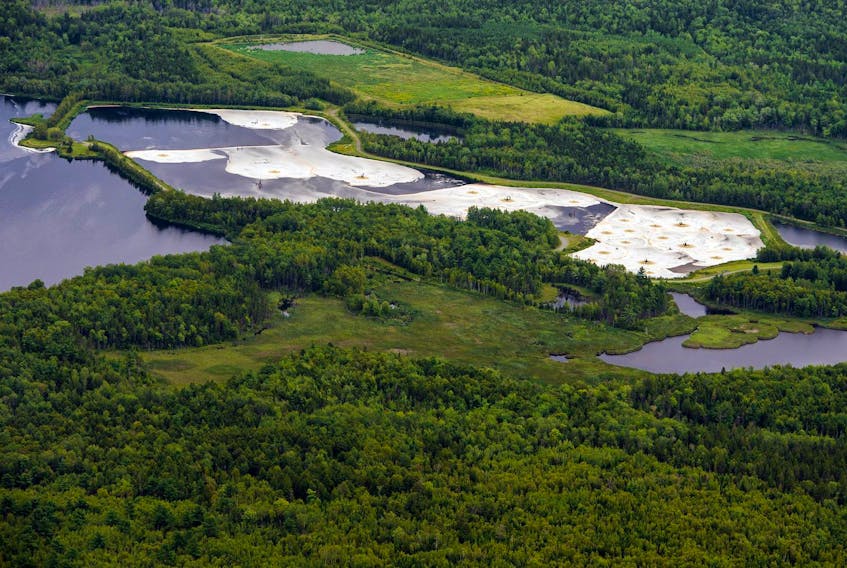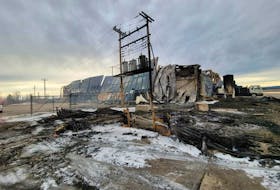A microcosm of what is supposed to be the future of forestry for this province envisioned by the much touted Lahey Report was happening this week on a private woodlot south of Amherst.
About 35 years ago the good quality spruce had been cut out of it to feed a sawmill across the road.
The red pine, white pine and poplar they couldn’t sell was left, along with balsam fir.
“Today we were back there dealing with the results of that forestry,” said Craig Tupper, a forester with Athol Forestry Co-operative.
“Yes, there are some good trees to give you a starting point of what could be there in the future but underneath all of it was this layer of what had come back after — balsam fir thickets and intolerant hardwoods. Things that don’t have much value today but are excluding your red spruces and shade tolerant hardwoods like sugar maple from becoming established.”
So under Tupper’s direction the contractor was cutting the shorter lived species while leaving the best trees — the ones containing valuable saw logs — to seed in below with an eye to a better forest in 30 years.
The poor quality wood headed to Northern Pulp where it fetches $38 a tonne.
It’s this type of harvest that the Lands and Forestry Department, based upon the recommendations of William Lahey’s review of Nova Scotia forestry practices, wants to see more of on Crown land in this province.
Three management paradigms
The idea is that the province’s Crown land will fall under one of three management paradigms — completely protected, industrial forestry and ecological forestry, the latter aiming to maintain wildlife habitat while producing higher value saw logs of long lived climax species of the Acadian Forest.
“Protecting and enhancing ecosystems should be the objective (the outcome) of how we balance environmental, social, and economic objectives and values in practising forestry in Nova Scotia,” reads the report that is being adopted by Lands and Forestry.
It acknowledges that rebuilding genetics of forests degraded by three centuries of high grading will take decades and in the interim will produce a large quantity of lower quality pulpwood while leaving many higher value trees to seed in the future.
The hiccup in the greatest paradigm shift this province’s forestry industry has seen in a generation is whether there's a market to drive this forestry work in the meantime.
On Jan. 31, 2020, the Boat Harbour effluent treatment facility owned by the province and leased to Northern Pulp is legislated to close.
The kraft pulp mill’s owner, Paper Excellence, has been vague about whether the corresponding mill closure will be permanent if it doesn’t get an extension to the Boat Harbour Act to allow it to continue operations while it builds (if granted environmental approval) a highly controversial new facility that would dump treated effluent into the Northumberland Strait.
As of right now, there’s no extension of the Boat Harbour Act — an extension that would violate an explicit commitment by the premier to the Pictou Landing First Nation — on the books.
A large coalition of fishermen, environmentalists and concerned citizens are adamently opposed to either an extension of the Boat Harbour Act or piping of treated effluent into the Northumberland Strait.
Life without Northern Pulp
So, what would no Northern Pulp mean for the implementation of the Lahey Report?
As it works toward a massive overhaul of how its manages this province’s forestry, Lands and Forests isn’t willing to discuss the elephant in the room.
“This is a hypothetical question,” said Lisa Jarrett, departmental spokeswoman in a written response to a Chronicle Herald interview request.
“The terms of reference outlines the information Northern Pulp needs to address in the focus report. Nova Scotia Environment continues to await the report, (Lands and Forestry) will not be commenting until after it is filed.”
Northern Pulp is aiming to file its answers to the Environment Department’s questions about its proposed effluent treated facility by month’s end.
There’s nothing hypothetical about a mill closure for the industry that depends on it.
Harvesting contractors have told The Chronicle Herald that Lands and Forestry staff have told them that they are forbidden from discussing the impacts of a Northern Pulp closure with industry.
So what happens to the Lahey Report’s lofty goals if a million tonnes a year of demand for softwood chips and low quality wood disappears from the market on Jan. 31, 2020?
“I had this exact conversation this spring in Maine on a tour with (report contributor) Bob Seymour,” said Tupper.
“I asked him directly, how do we implement your report’s recommendations without a large consumer of poor quality wood? He said point-blank, ‘you don’t’.”
Seymour, a forester and retired University of Maine professor, couldn’t be reached by The Chronicle Herald for comment.

A different type of forest
However the report’s premise is that the forestry work that will push Crown forests toward longer lived, higher-value species living in mixed stands that are cut in patches rather than large swaths will in the short term produce a larger per centage of pulp wood.
The silviculture work, like pre-commercial thinnings, that doesn’t produce something to sell but opens up space in the forest for the big trees to grow will continue to be funded through the registry of buyers programs that sees sawmills and pulp mills contribute $3 for every tonne of softwood they buy and 60 cents for every tonne of hardwood.
“So what’s going to happen is the day after Northern Pulp shuts, the three largest sawmills will shut because they can’t get rid of their woodchips,” said Andrew West.
As the Nova Scotia representative for woods brokerage H.C. Haynes Inc., West deals in the hard math of forestry supply and demand.
The sawmills will close, he says, because they get about $1,400 per load of woodchips they send as a byproduct of lumber production to Northern Pulp. The bigger sawmills send four or five tractor trailors a day.
If three big sawmills and Northern Pulp shut then that’s nearly half the silviculture funding out of the equation.
Then there’s the drop in demand for forest products.
“If I’m paying $30 a tonne right now roadside for a clearcut, I know that with a market for pulp I’d be paying $40 a tonne for that to be done as a selective cut,” said West, doing math on a piece of paper on Tuesday.
“With a selective cut 65 per cent of what comes out is going to be pulp. But if I don’t have a market for that pulp then I’m going to need to pay $97 a tonne. The math doesn’t work.”
The economic impact
The argument of Tupper and West is with no market for low-quality wood and silviculture funding drying up the ecological forestry leg of Lahey’s three-part management regime is not economically viable.
They argue the province’s 30,000 private woodlot owners — 250 of which are represented by Tupper — will also see their land value drop.
“So the stumpage today to the landowner averages thirty five bucks (per tonne) for studwood, that’ll go to $10 a tonne overnight,” said West.
But not everyone in the industry shares their logic.
“If the people at the top want to interpret the situation as negative or that it’s impossible to implement Lahey’s recommendations then that doesn’t help,” said Wade Prest, a Mooseland harvester and advocate for ecological forest management.
“If the Department of Lands and Forestry sincerely tries to implement the recommendations, cooperate with industry, have wood move around to right mills and find alternative markets for wood chips, then answers will be found.”
Prest argues that a significant decrease in harvesting is needed in the near term to improve soil health and forest regeneration.
“Under normal stand development, the strong trees overwhelm the weaker and those weaker die and go back into soil and go to nourish the continued health of the stand,” said Prest.
“We are in a paradigm now that we can’t let small trees die because that would be wasting them and that if we don’t cut the small trees the big won’t grow up. We don’t know if silviculture is throwing a life ring to a dying sailor or is it part of the problem?”
Asked if he thought Lands and Forestry was planning for a potential Northern Pulp closure, Prest responded, “No, I don’t.”
Tupper agrees with Prest that our forests have been degraded and that if you left them grow it will help the soil and eventually — generations hence — result in healthy timber stands that also provide habitat for wildlife.
His argument is based on timelines.
“Those of our generation that are purchasing and counting on some income from tending these partially degraded woodlots to pay the taxes or as retirement investment or to help put our kids through school, are suddenly left with fewer options, tools and less value to work with,” said Tupper.
RELATED:
- Fishermen want to see studies from Northern Pulp
- Northern Pulp suppliers, Indigenous leaders talk closure over kitchen table
- Nova Scotia not told of new federal plan for Northern Pulp
- Federal environment minister calls for new Northern Pulp review
- EDITORIAL: Smart money is on Northern Pulp deadline extension
- UNIFOR: 2,700 jobs could be lost should Northern Pulp close its doors









